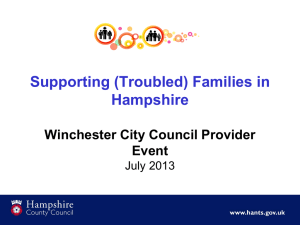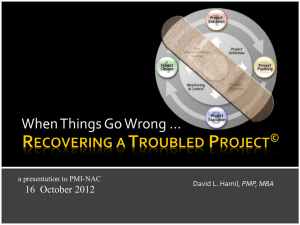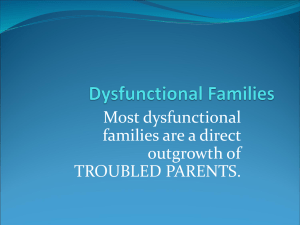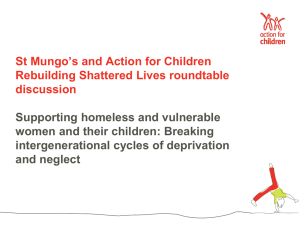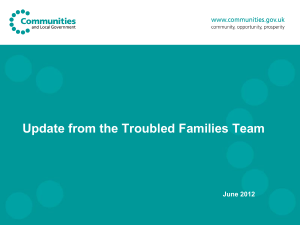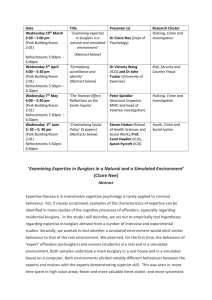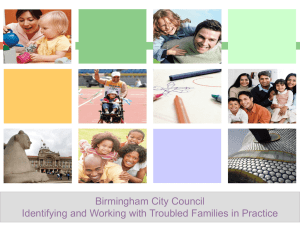The troubled families agenda - what does it all mean?
advertisement
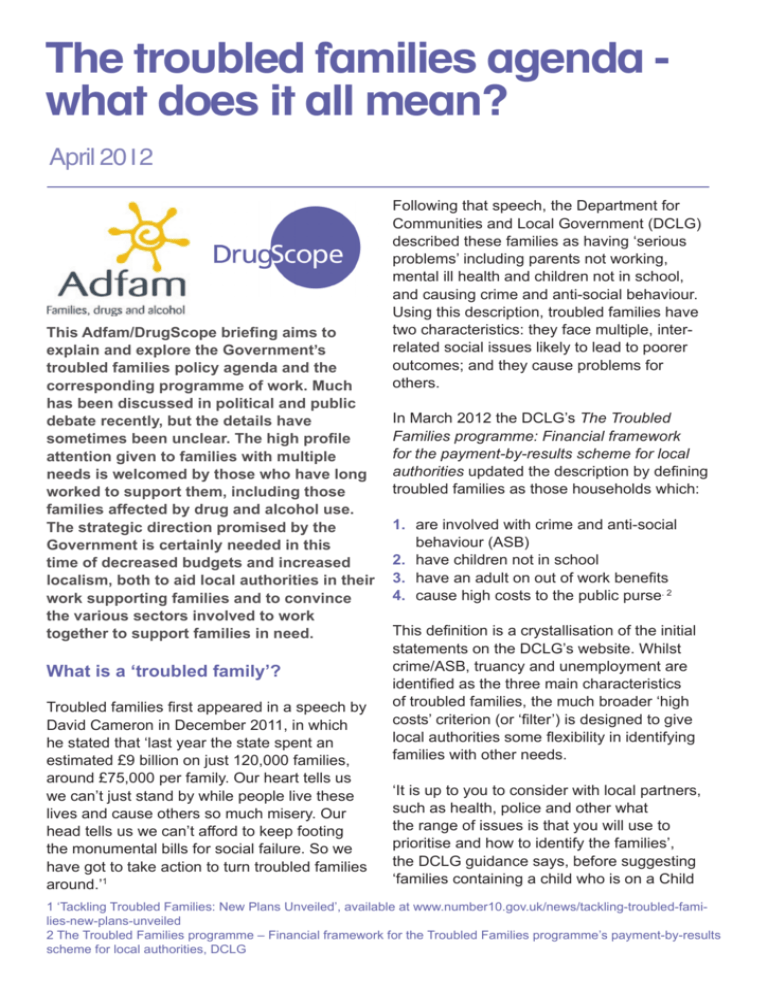
THE TROUBLED FAMILIES AGENDA - WHAT DOES IT ALL MEAN? The troubled families agenda what does it all mean? April 2012 This Adfam/DrugScope briefing aims to explain and explore the Government’s troubled families policy agenda and the corresponding programme of work. Much has been discussed in political and public debate recently, but the details have sometimes been unclear. The high profile attention given to families with multiple needs is welcomed by those who have long worked to support them, including those families affected by drug and alcohol use. The strategic direction promised by the Government is certainly needed in this time of decreased budgets and increased localism, both to aid local authorities in their work supporting families and to convince the various sectors involved to work together to support families in need. What is a ‘troubled family’? Troubled families first appeared in a speech by David Cameron in December 2011, in which he stated that ‘last year the state spent an estimated £9 billion on just 120,000 families, around £75,000 per family. Our heart tells us we can’t just stand by while people live these lives and cause others so much misery. Our head tells us we can’t afford to keep footing the monumental bills for social failure. So we have got to take action to turn troubled families around.’1 Following that speech, the Department for Communities and Local Government (DCLG) described these families as having ‘serious problems’ including parents not working, mental ill health and children not in school, and causing crime and anti-social behaviour. Using this description, troubled families have two characteristics: they face multiple, interrelated social issues likely to lead to poorer outcomes; and they cause problems for others. In March 2012 the DCLG’s The Troubled Families programme: Financial framework for the payment-by-results scheme for local authorities updated the description by defining troubled families as those households which: 1. are involved with crime and anti-social behaviour (ASB) 2. have children not in school 3. have an adult on out of work benefits 4. cause high costs to the public purse. 2 This definition is a crystallisation of the initial statements on the DCLG’s website. Whilst crime/ASB, truancy and unemployment are identified as the three main characteristics of troubled families, the much broader ‘high costs’ criterion (or ‘filter’) is designed to give local authorities some flexibility in identifying families with other needs. ‘It is up to you to consider with local partners, such as health, police and other what the range of issues is that you will use to prioritise and how to identify the families’, the DCLG guidance says, before suggesting ‘families containing a child who is on a Child 1 ‘Tackling Troubled Families: New Plans Unveiled’, available at www.number10.gov.uk/news/tackling-troubled-families-new-plans-unveiled 2 The Troubled Families programme – Financial framework for the Troubled Families programme’s payment-by-results scheme for local authorities, DCLG 2. THE TROUBLED FAMILIES AGENDA - WHAT DOES IT ALL MEAN? Protection Plan’, ‘families subject to frequent police call-outs or arrests’ and ‘families with health problems’ as suitable candidates under the fourth ‘causing high costs’ filter. The health criterion is further broken down to include emotional and mental health problems, drug and alcohol misuse, long-term health conditions, health problems caused by domestic abuse and under 18 conceptions.3 The Government has acknowledged that local authorities will naturally already be in contact with many of the families who fall within these domains. As such, the troubled families work represents less a brand new programme of activity with a new set of aims, and more a new, funded, structured opportunity to undertake sustained work with families local authorities already know: ‘an opportunity to take a systematic and strategic approach to these most challenging of families who have concerned services for years’.4 Is it true that there are 120,000 of them? This figure has been widely invoked by Government in the debate about troubled families, including by the Prime Minister himself. It is, however, of questionable validity regarding the current agenda, having been calculated by the Cabinet Office’s Social Exclusion Task Force5 using 2005 data from the Families and Children Study (FACS).6 The 120,000 figure was arrived at based on the seven criteria below, with a family judged ‘troubled’ if it exhibited five or more of them. This research also estimated that around £9 billion is spent on troubled families annually, which equates to £75,000 per family per year. The criteria used were: • • • • • • • no one in the family in work living in poor or overcrowded housing no parent has any qualifications mother has mental health problems a parent with a longstanding illness, disability or infirmity a low income an inability to afford a number of food or clothing items. Despite the fact that the new defining characteristics are different from the original study, the figure of 120,000 has continued to appear. The DCLG reasserts that ‘the Prime Minister has confirmed his intention to ensure that 120,000 troubled families are ‘turned around’ by the end of this Parliament’. On the other hand, in a recent speech at Number 10, the Prime Minister said ‘whether you say there are 120,000 or 200,000 or 50,000, we all know there are some deeply troubled families in our country who are responsible for a huge amount of social problems, for themselves but also for the wider community’.7 It is perhaps fair to say that the exact number of families isn’t crucially important – what matters is the investment, the intent and the work that’s to be done with them. When the policy was launched by the Government in December 2011 the figure of 120,000 was the best available and was therefore used to convey a sense of scale. It has continued to be used as a basis on which to provide local authorities with ‘indicative numbers of troubled families in their area’.8 It’s now largely up to local authorities to identify their troubled families and provide appropriate interventions - acknowledging that not all work will be successful, the DCLG suggests 3 Ibid 4 Ibid 5 Read more at www.cabinetoffice.gov.uk/social_exclusion_task_force.aspx 6 Read more at www.natcen.ac.uk/study/families--children-study 7 Transcript: Troubled Families reception, www.number10.gov.uk/news/transcript-troubled-families-reception 8 The Troubled Families programme – Financial framework for the Troubled Families programme’s payment-by-results scheme for local authorities, DCLG 3. THE TROUBLED FAMILIES AGENDA - WHAT DOES IT ALL MEAN? working with more families than are specified by the indicative numbers. This deliberate over-estimation should then accommodate for the inevitable percentage of families which are not turned around, and the payment outcomes which can therefore not be claimed for (discussed fully later). The DCLG’s Troubled Families Team created to run the programme of work advises local authorities - ‘consider which families you would like to work with in your areas in conjunction with other local agencies, bearing in mind the public commitment to work with families whose children are not attending school, who are involved in crime and/or anti-social behaviour, not in work, and who create high costs for public services’.9 Haven’t we been here before? Yes, in some ways. Previous initiatives have focused on chaotic families, families at risk, families with multiple problems and families with complex needs, with the Family Intervention Programme (or FIP) a recent forerunner. Much recent debate in politics and policy has focused on how best to help these families (however they are described), as well as, crucially, what form of intervention is most appropriate. The importance of early intervention has been highlighted by Graham Allen MP’s recent reports Early Intervention: The Next Steps10 and Early Intervention: Smart Investment, Massive Savings11 ; Professor Eileen Munro’s 2011 Review of Child Protection12 and recent material from the Centre for Social Justice such as Early Intervention: Good Parents, Great Kids, Better Citizens.13 Each of the characteristics laid out in the framework (truancy, unemployment, crime or ASB) represents a major challenge: a family exhibiting three of them suggests a certain level of entrenched and compounded issues which have gone beyond the stage where early intervention is effective. Most of the dialogue and literature on working with families with entrenched problems is not prescriptive on what model of intervention should be used, with the specific detail being left up to local decisionmaking processes. A previous high-profile intervention that may be used as the basis for a model is the Family Intervention Project (FIP), which used a single central keyworker to support families across numerous areas of need. FIPs were positively evaluated in 2010 by NatCen14 and are recognised to provide an effective model by the current government. A feature of FIPs that fits with the troubled families work is the long-term, dedicated focus on working with families over a sustained period. The Troubled Families Team has said that ‘evidence from past work with families including FIPs and Family Pathfinders should be helpful and relevant’15 to local authorities. Where is the money coming from? The Government has pledged £448 million. This is to be contributed to by a number of government departments – DCLG (£50 million annually), Department for Education (£30 million annually plus an initial £15 million), Home Office (£15 million in 2012/13, £30 million in 2013/14 and £30 million in 2014/15), Department of Health (£15-25 million annually), Ministry of Justice (£8-9 million annually) and Department of Work and Pensions (DWP) (no figure available).16 This £448 million is judged to be 40% of the total money needed to work 9 Follow up from Troubled Families meeting letter – Nick Burkitt, Troubled Families Team. 10 Available at www.dwp.gov.uk/docs/early-intervention-next-steps.pdf 11 Available at www.cabinetoffice.gov.uk/sites/default/files/resources/earlyintervention-smartinvestment.pdf 12 Available at www.education.gov.uk/munroreview/downloads/8875_DfE_Munro_Report_TAGGED.pdf 13 Available at www.centreforsocialjustice.org.uk/client/downloads/EarlyInterventionpaperFINAL.pdf 14 www.education.gov.uk/publications/eOrderingDownload/DCSF-RR215.pdf 15 Follow up from Troubled Families meeting letter – Nick Burkitt, Troubled Families Team. 16 All departmental figures quoted from Hansard. 4. THE TROUBLED FAMILIES AGENDA - WHAT DOES IT ALL MEAN? successfully with the 120,000 troubled families and will be made available to local authorities partly through a Payment by Results (PbR) scheme. The remaining 60% will have to be found by local authorities in the existing budgets of local bodies. A grant of £20,000 has also been made available for (and taken up by) each ‘upper-tier local authority’ to get them ready for the new troubled families’ agenda. This is to be used to ‘facilitate the deployment of either senior-level internal resources to do this work and/or the purchasing of external advice and expertise focused on this programme’, ‘formulate the business case needed to underpin local resource commitments’ and ‘plan the outcome tracking arrangements necessary to both focus services on the success criteria and demonstrate success’.17 Community Budgets will play a key part in the troubled families work and have been mentioned by the Prime Minister specifically. They were intended to be flexible, pooled budgets held at a local level and part of a move away from central budgeting and target setting and towards a model where local authorities themselves could decide on which community priorities should be addressed, and with how much money. An initial 16 areas took part in a pilot but in practice some found it hard to get local services to agree to fully pool their budgets.18 The Community Budgets initiative has continued, with another 100 or so areas lined up to adopt them in 2012/13, but rather than continuing to aim for a locally pooled budget, local authorities are using them more as a means to share resources, good practice and expertise. Given the collaborative, multi-agency working that Community Budgets support, they should be very useful for local pursuit of troubled families outcomes. Lastly, the European Social Fund (ESF) is a European Union-wide project aimed at reducing unemployment. It is administered in the UK by the DWP19 and although ESF money cannot be pooled with community budgets the ESF is judged by the Troubled Families Team to be ‘an important tool for local authorities to use in order to meet the national ambition of turning around the lives of 120,000 Troubled Families’.20 Isn’t this all a bit expensive? It is a lot of money, especially in a time of such budget cutting. The Government’s argument, though, is that investment is exactly what is needed now to prevent troubled families costing the state much more in the future. The £9 billion estimated to be currently spent per year on troubled families is made up of the costs of failing to intervene, including child-protection spending to safeguard children at risk; adoption or fostering costs for those deemed most at risk; spending in the criminal justice system on anti-social behaviour and crime; benefit payments for workless parents; and healthcare costs associated with substance use and chronic mental or physical ill health. This dwarfs the proposed £448 million figure for investment. If this £9 billion can be substantially reduced by effective intervention then the £448 million will be recouped many times over. Who’s going to do the work? Nationally, the funding is cross-departmental. Given the broad range of issues that affect troubled families, and the number of different services required to support them, the fact that funding is coming from a variety of Government sources is welcome. A new Troubled Families Team led by Louise Casey has been created within the DCLG to provide national leadership around this agenda. It started work on 1 November 2011 and coordinates the troubled families programme from Whitehall. 17 Troubled Families – Initial Plans, letter from Joe Tuke, Troubled Families Team 18 Read more at www.communities.gov.uk/localgovernment/decentralisation/communitybudgets 19 Read more at www.dwp.gov.uk/docs/esf-la-info-pack-presentation.pdf 20 Follow up from Troubled Families meeting letter – Nick Burkitt, Troubled Families Team. 5. THE TROUBLED FAMILIES AGENDA - WHAT DOES IT ALL MEAN? As noted previously, the £448 million will be available to local authorities partly through a PbR system. This system has recently been laid out by the DCLG and provides a sliding scale on which local authorities are paid. In order to provide local authorities with the resources needed to start work, some of the funding (which equates in total to around £4,000 per family) will be made available up-front. For 2012/13, 80% of the money from Government can be claimed at the start of the year and 20% will be paid on achievement of outcomes. This shifts to 60% up-front and 40% on achievement of outcomes in 2013/14, and 40% up-front and 60% based on outcomes in 2014/15. This means that over the full three years, 50% more money is being made available up-front for work with families than will be paid under the PbR system. Local authorities are responsible for identifying the troubled families in their areas and creating strategies on how to intervene effectively. The DCLG expects local authorities to have identified around one-third of their families in 2012/13 and the majority in 2013/14, although it acknowledges that ‘there is some scope for further discussions with individual local authorities about these figures, within the constraints of our budget’.21 Local authorities are also required to appoint a ‘trouble-shooter’ who will be the strategic coordinator of all the work, organising effective partnership working between the various agencies which support the families. The Troubled Families Team has urged local authorities to ‘appoint your coordinator as soon as possible…[ensure] they are sufficiently senior to grip local delivery and radically boost the pace and scale of work’.22 If they already do so, local authorities are encouraged to continue inputting data on families into the Natcen Family Intervention Information System, the Government’s mechanism for tracking data on work or interventions with families.23 It is also worth noting that, judging by the language used, the troubled families work seems to be an offer from the Government rather than an order - ‘we hope that you will take advantage of the opportunity to invest this relatively large amount of resource’.24 There appears to be no compulsion for local authorities to take part in the programme, and it will therefore be their choice to engage in this work and pool necessary additional funds. How will we know if it’s working? As noted, local authorities are obliged to report the results of their work with families back to the Troubled Families Team to trigger their PbR payments. As the DCLG states, ‘the ‘results’ are largely the inverse of the ‘problem’ criteria’25 identified earlier. The results by which the troubled families are judged to have been ‘turned around’ can be split into three categories: education, ASB and work. The education outcome is all children having fewer than three fixed-term exclusions and less than 15% unauthorised absences from school in the last three terms; the ASB outcomes are a 60% reduction in ASB and a 33% reduction in offending rates for under-16s in the last six months; and the work outcomes are an adult volunteering for the Work Programme or European Social Fund provision in the last six months and an adult moving from benefits to continuous employment. These outcomes can be combined in different ways – for instance the last result of an adult moving into continuous employment can be claimed instead of all the previous ones but not as well as them. Further details on the amounts that can be claimed for the results are 21The Troubled Families programme – Financial framework for the Troubled Families programme’s payment-byresults scheme for local authorities, DCLG 22 Follow up from Troubled Families meeting letter – Nick Burkitt, Troubled Families Team. 23 Available at www.fipsinformation.co.uk. 24 The Troubled Families programme – Financial framework for the Troubled Families programme’s payment-byresults scheme for local authorities, DCLG 25 Ibid 6. THE TROUBLED FAMILIES AGENDA - WHAT DOES IT ALL MEAN? available in The Troubled Families programme – Financial framework for the Troubled Families programme’s payment-by-results scheme for local authorities. The Troubled Families Team will be responsible for evaluating the overall impact of the project. As well as ascertaining whether local authorities have delivered PbR results, the evaluation will assess broader outcomes, such as ‘the difference it has made to families as well as to the way services are delivered and the savings that have been achieved by local areas’.26 Local authorities are expected to work with the Government on the research and evaluation of the troubled families programme. The FIP programme seems to be the closest existing example of a model likely to be adopted for the troubled families initiative. The NatCen evaluation27 of FIPs was positive – stating that ‘results continue to show overwhelmingly positive outcomes for families’. Some of the measures that the troubled families work could be judged on might therefore be inferred from the FIP evaluations and areas of success. What are the risks? FIPs do have their detractors however. For example, the Centre for Crime and Justice Studies has claimed that ‘FIPs fail in multiple ways: by targeting the wrong people for the wrong reasons; by targeting false ‘causes of ASB’ while failing to tackle the real underlying causes in those targeted; by failing to deliver support in key areas like mental health; by failing to deliver sustained changes in family behaviour or reduced ASB in the community’.28 In addition, any system based on PbR will have a number of risks. • As the outcome payment is to the local authority, there is a direct financial interest in demonstrating success – in a time of all-round decreased funding there is an increased potential for ‘gaming’ of the system. The PbR mechanism asks for selfdeclaration of results approved by internal audit arrangements, with only the threat of ‘a small number of ‘spot checks’ in a sample of areas’29 as a deterrent. • Cherry-picking ‘easier’ families to work with and neglecting the ones with the most entrenched problems will also lead to greater financial reward unless outcome payments are calibrated to incentivise engagement with the most marginalised. The entrenched nature of the problems also means that a long-term vision is needed to carry out any work and make the real change the Government wants. The overall proposed timescale for the troubled families work is based on ‘turning around’ families by 2015, with literature from the Government even stating ‘you should be able to claim your results-based payments around 12 months after the intervention has started’.30 Since claiming these payments is dependent on reversing the entrenched problems of ASB, truancy and unemployment the Government uses to characterise troubled families, as well as effectively bridging the gaps between the different services which support families, a year does not sound like a very long time to do this - especially since the DCLG has itself acknowledged that it is ‘incredibly hard for families to start unravelling their problems’.31 Because of this, every effort should be made to ensure both that the troubled families work is successful and that it establishes partnerships and ways of working that can continue beyond 26 Ibid 27 Available at www.education.gov.uk/publications/eOrderingDownload/DCSF-RR215.pdf 28 www.crimeandjustice.org.uk/opus1786/Family_intervention_projects.pdf 29 ‘Tackling Troubled Families: New Plans Unveiled’, available at www.number10.gov.uk/news/tackling-troubled-families-new-plans-unveiled 30 Ibid 31 Ibid 7 THE TROUBLED FAMILIES AGENDA - WHAT DOES IT ALL MEAN? 2015. Efforts should also be made to ensure that the high profile focus and media attention on troubled families does not detract from investment in earlier preventative measures, interventions and systemic changes. Whilst it’s undeniably true that some families do consume more resources and have more acute needs than others, the polar dividing of families into one relatively small group marked ‘troubled’ and another much larger one marked ‘everyone else is problematic. What resources, for example, will be devoted to the families that fall just below the cut-off for the officially troubled group? And might not this segregation of society also risk stigmatising the families local authorities do identify as their targets? Efforts must be made not to reinforce the public opinion, often fuelled by the media, that there exist a number of badly behaved ‘problem families’ which constitute an irreversible drain on society and are categorically different from the rest of us. What does it mean for the drug/ alcohol sector? Interestingly, despite references from the Prime Minister in various speeches, drug and alcohol use has not appeared very prominently so far in public or political discussion. Though it was not specified as one of the seven criteria used to calculate the 120,000 figure, ‘drug and alcohol misuse’ does appear within the fourth filter in the PbR document (the ‘high costs’ criterion which allows local authorities to use their discretion in selecting families). However, since it is part of a discretionary measure, this means that if local authorities wish to they can wholly ignore alcohol and drugs when identifying families; it’s also worth noting that when drugs and alcohol do appear, it’s as a manifestation of high costs for local authorities, rather than as something troubling to families in their own right. However, as local authorities will have a large say in identifying troubled families in their own area it’s possible they may more explicitly recognise substance use as a contributing factor. The loss of the nominally ring-fenced pooled treatment budget for drug treatment in April 2013 and pressures on local funding sources could mean that funds previously ear-marked for drug and alcohol treatment will be spent on other local public health priorities. The troubled families agenda could therefore represent for local authorities a chance to lever in some central Government investment in drug and alcohol support in the wake of potential disinvestment elsewhere. The inter-agency work on troubled families could also provide a good opportunity to break down some of the systemic barriers that have typically arisen when services support families affected by substance use and with other needs. It should have a positive effect beyond the three-year span of the project by bringing together family support, drug and alcohol treatment, housing, domestic violence services and others to work together, open channels of communication and improve joint working. Whilst it’s certainly true that not all troubled families will experience substance use and not all families with substance use problems will be ‘troubled’ (as we mean it here), many of the 120,000 families will have been affected by drugs or alcohol at some point, whether personally, in the family or in the local community. The UK Drug Policy Commission’s Supporting the Supporters32 has estimated that 1.5m adults are affected by a relative’s drug use, and this figure would be much higher if it included alcohol. 32 Available at www.ukdpc.org.uk/wp-content/uploads/Policy%20report%20-%20Supporting%20the%20supporters:%20families%20of%20drug%20misusers%20%28policy%20briefing%29.pdf 8. THE TROUBLED FAMILIES AGENDA - WHAT DOES IT ALL MEAN? What does it mean for the voluntary and community sector? It isn’t clear yet. There is a lack of detail on the actual delivery and commissioning opportunities for VCS organisations. We know local authorities will be able to commission ‘external advice and expertise’33 to help with the work. Also, presumably, that since the project is specified in terms of results and not procedures, they are free to commission whichever provider is able to do the job best for the least money, which should include many VCS providers. VCS organisations have a strong track record of reaching out to and engaging the most marginalised, including individuals and families who may initially be reluctant to make contact with statutory services. While we hear less about the ‘Big Society’ there is still interest in Government in the role of civil society organisations. There will be many VCS bodies – including grassroots organisations - currently well positioned to help the families local authorities identify as troubled, and hopefully every measure will be taken to ensure that all commissioning and tendering processes are open and equitable for all potential providers. The expertise of the voluntary sector should also be consulted in the identification of troubled families at a local level, and the planning and evaluation of the programme in general. This briefing was prepared by Adfam, working in collaboration with DrugScope Further reading on troubled families • ‘The Troubled Families programme: Financial framework for the Troubled Families programme’s payment-by-results scheme for local authorities’ (pdf) is the best place for up-to-date information from the Government, especially on the financial reward scheme for the work. • Troubled Family Estimates Explanatory Note (pdf) – DCLG • ASB Family Intervention Project (pdf) – NatCen • Troubled Families FAQ - DCLG • Troubled Families – initial plans letter (pdf) – Joe Tuke, Troubled Families Team • Follow up from Troubled Families meeting letter (Word doc) – Nick Burkitt, Troubled Families Team • Troubled Families ‘What Works?’ (pdf) – Interface Associates UK Notes Adfam and DrugScope would like to thank Ansvar insurance and all those who attended the troubled families round-table event and contributed to the creation of this briefing. Contacts Adfam Joss Smith, Director of Policy and Regional Development, j.smith@adfam.org.uk DrugScope Marcus Roberts, Director of Policy and Membership, marcusr@drugscope.org.uk 33 Troubled Families – Initial Plans, letter from Joe Tuke, Troubled Families Team
